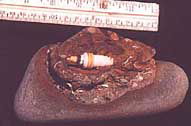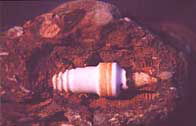Sparking Interest in Rapid Rocks
Originally published in Creation 21, no 4 (September 1999): 6.
Examination of rapid formation of rocks by looking at the example of a rock formed around a modern spark plug.
We have often featured real-life examples in Creation magazine showing it does not need millions of years for solid rock and/or fossils to form. Given the right conditions, they form very rapidly.
Shown here are the porcelain remains of a spark plug embedded in a rocky matrix, which is cemented to a stone. It was found about a year ago by reader Chuck Sheldon and his nine-year-old daughter Kristie, on a beach in Ventura County, California.
Mr Sheldon believes that the plug most likely dates back no further than the 1950s, and was probably from a marine engine.1The exposed metal components of the plug (the thread and the metal jacket, including the flat surfaces for a spanner) have corroded away. However, they have left clear impressions of where they were.

The top of the spark plug (i.e., the right end shown above) is firmly embedded in the rock matrix while the bottom (left end) protrudes into space. The limestone matrix is made of fragments of shells, wood, and other rock, cemented together.

At the left end the hollow rock matrix, termed a “cast”, preserves the shape of the plug’s metal base after it rusted away.
Many fossils found in the field are also only the impressions of what was originally there. In other cases, notably shellfish, part of the creature is cemented into the rock matrix. Clearly, both of these aspects feature in this specimen. It is technically appropriate to refer to this as a fossil, in the same sense as one can talk of a fossil ant nest, for example. After all, the preserved evidence is of something that was built by living organisms (in this case, people).
There is really nothing surprising about this specimen. But many people are fascinated and astonished by such examples, simply because of the continuous bombardment with long-age ways of thinking in our culture.
Footnotes
- The plug appears to be a fairly modern design. The thread on the base is 18 mm diameter, with 18 turns per inch. Modern vehicle engines use smaller diameter threads, with more turns. A dropped spark plug from someone working on a marine engine at sea is the most likely scenario.

Answers in Genesis is an apologetics ministry, dedicated to helping Christians defend their faith and proclaim the good news of Jesus Christ.
- Customer Service 800.778.3390
- Available Monday–Friday | 9 AM–5 PM ET
- © 2026 Answers in Genesis

